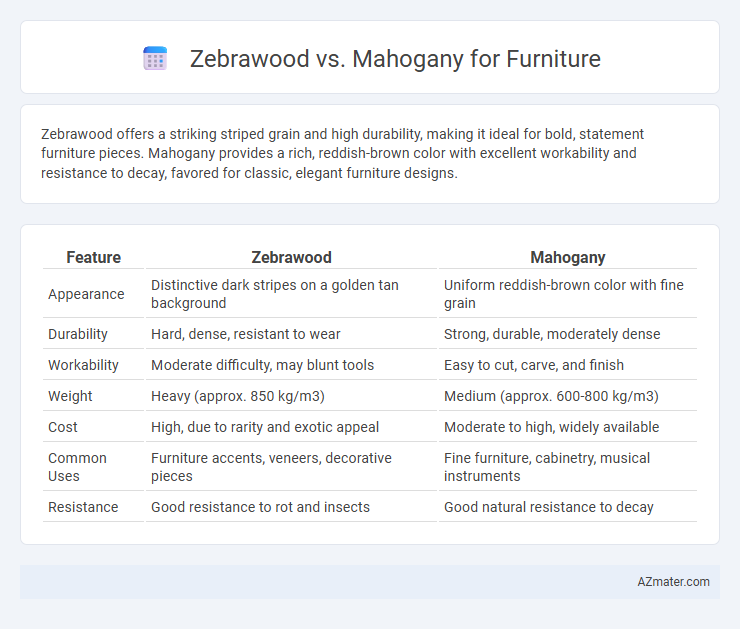Zebrawood offers a striking striped grain and high durability, making it ideal for bold, statement furniture pieces. Mahogany provides a rich, reddish-brown color with excellent workability and resistance to decay, favored for classic, elegant furniture designs.
Table of Comparison
| Feature | Zebrawood | Mahogany |
|---|---|---|
| Appearance | Distinctive dark stripes on a golden tan background | Uniform reddish-brown color with fine grain |
| Durability | Hard, dense, resistant to wear | Strong, durable, moderately dense |
| Workability | Moderate difficulty, may blunt tools | Easy to cut, carve, and finish |
| Weight | Heavy (approx. 850 kg/m3) | Medium (approx. 600-800 kg/m3) |
| Cost | High, due to rarity and exotic appeal | Moderate to high, widely available |
| Common Uses | Furniture accents, veneers, decorative pieces | Fine furniture, cabinetry, musical instruments |
| Resistance | Good resistance to rot and insects | Good natural resistance to decay |
Introduction to Zebrawood and Mahogany
Zebrawood, known for its striking striped grain pattern and durability, is prized in high-end furniture making for its exotic appearance and strength. Mahogany offers a rich reddish-brown color and smooth texture, making it a classic choice for traditional and elegant furniture styles. Both woods provide exceptional workability, but Zebrawood stands out for its bold aesthetics, while Mahogany is favored for its timeless warmth and fine finish.
Origin and Botanical Background
Zebrawood, scientifically known as Microberlinia brazzavillensis, originates primarily from Central African countries such as Gabon and Cameroon, characterized by its distinctive striped grain pattern resembling a zebra's coat. Mahogany encompasses several species in the Swietenia genus, native to the Americas, especially Central and South America, cherished for its deep reddish-brown color and fine grain texture ideal for high-quality furniture. Both woods belong to the angiosperm group but differ significantly in geographic origin, grain appearance, and botanical characteristics, influencing their aesthetic and functional applications in furniture making.
Visual Appearance and Grain Patterns
Zebrawood features striking, bold grain patterns with dark brown to black stripes on a light golden to pale yellow background, offering a distinctive, exotic appearance ideal for statement furniture pieces. Mahogany exhibits a more uniform, fine grain with a rich reddish-brown color that deepens over time, providing a classic and elegant look favored in traditional furniture design. The contrasting visual aesthetics make Zebrawood suitable for modern, eye-catching designs, while Mahogany suits timeless, warm interiors.
Durability and Hardness Comparison
Zebrawood, known for its distinctive striped grain, offers a Janka hardness rating of approximately 1570, making it highly durable and resistant to wear, comparable to the 800-900 range of common mahogany species. African mahogany, while softer with a Janka hardness around 900, provides excellent stability and workability, favored for intricate furniture details. Zebrawood's superior hardness ensures better scratch and dent resistance, ideal for high-traffic furniture surfaces, whereas mahogany's moderate hardness balances durability with ease of craftsmanship.
Workability and Ease of Crafting
Zebrawood's coarse texture and interlocking grain make it moderately challenging to work with, requiring sharp tools and careful sanding to achieve a smooth finish. Mahogany excels in workability due to its fine, straight grain and uniform texture, allowing for effortless cutting, carving, and sanding. Furniture crafted from mahogany typically exhibits cleaner joints and finer details, while zebrawood demands more skilled craftsmanship to avoid splintering and achieve precision.
Common Furniture Applications
Zebrawood and mahogany are both prized for furniture making, with zebrawood commonly used in decorative veneers, tabletops, and accent pieces due to its striking striped grain and durability. Mahogany is favored for high-end furniture such as cabinets, chairs, and intricate carvings because of its rich reddish-brown color, smooth texture, and excellent workability. Both woods perform well in indoor furniture applications, but mahogany typically offers better resistance to warping and aging.
Environmental Impact and Sustainability
Zebrawood, indigenous to West Africa, is classified as a moderately sustainable species when harvested under certified programs such as FSC, but overexploitation still threatens its natural populations. Mahogany, particularly Honduran mahogany, faces significant sustainability challenges due to illegal logging and slow growth rates, leading to stricter regulations and certifications to ensure environmental protection. Consumers prioritizing eco-friendly furniture should look for FSC-certified sources of both woods while considering alternative species with faster regeneration times to minimize ecological footprints.
Cost and Market Availability
Zebrawood is generally more expensive than mahogany due to its unique striped grain and limited supply, making it a premium choice for high-end furniture. Mahogany offers a more affordable option with widespread market availability, favored for its durability and rich color. Furniture manufacturers often select mahogany for cost-effective projects while reserving zebrawood for distinctive, luxury designs.
Maintenance and Longevity
Zebrawood features high durability and resistance to wear, making it suitable for furniture that demands long-lasting performance with minimal maintenance, as its dense grain repels moisture and resists scratches. Mahogany, renowned for its rich color and smooth texture, requires regular polishing and protection from excessive moisture to maintain its longevity but ages gracefully, often developing a desirable patina over time. Both woods benefit from proper sealing and conditioning, though Zebrawood generally offers greater resilience in high-traffic or humid environments.
Choosing the Right Wood for Your Needs
Zebrawood offers a striking, exotic grain pattern ideal for statement furniture pieces requiring durability and distinctive aesthetics, while Mahogany is prized for its rich, warm tones and smooth texture suitable for classic, elegant designs. For high-traffic furniture or bold interior accents, Zebrawood's hardness and unique striping provide both resilience and visual interest. Mahogany's easier workability and resistance to swelling make it preferable for fine craftsmanship and timeless, luxurious finishes.

Infographic: Zebrawood vs Mahogany for Furniture
 azmater.com
azmater.com